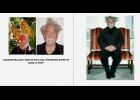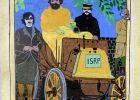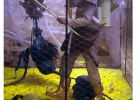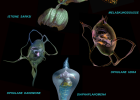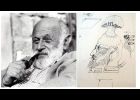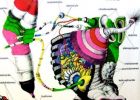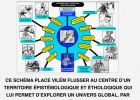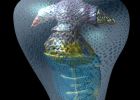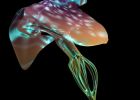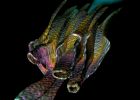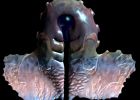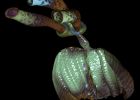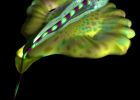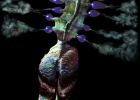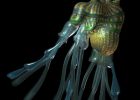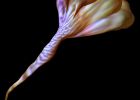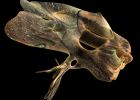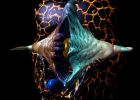En hommage à Louis Bec (1936-2018)
Louis Bec, who died three years ago, was one of Flusser’s closest friends, one of the few with whom he never quarreled, and the only one with whom he co-authored a book. They met every Saturday to exchange their ideas. This essay discusses Bec’s life, his creation of the “Institut Scientifique de Recherche Paranaturaliste”, his work as a “zoosytematician” and his theories about bio-art and artificial life, some of his artistic installations, such as the Sulfanogrades, as well as their most important project, the Vampyroteuthis infernalis. Their friendly and intellectual complicity lasted seventeen years: it is difficult to imagine what Flusser would have been without Bec, or Bec without Flusser.
Vampyroteuthis as a bioluminescent lighthouse to think under the livings. Some mutations: From 1981 to 1991
This contribution is about a translation of the book Vampyroteuthis Infernalis into a dialogic media. In Vampyroteuthis Infernalis, Vilém Flusser describes an abyssal creature, opposite in every point with humans. From 1981 to 1991, the book mutates within the writing process of Flusser engaging with letters, oral dialogues, essays, courses and translations. There is a genealogy of the Vampy and of the Vampyroteuthian model from the French version to the Brazilian one. I will call this model Vampy, a borrowed term from the relationship between Louis Bec and Vilém Flusser (Marburger 2016). The article emphasizes Flusser’s programmatic vision in the Vampyroteuthis. How can the philosophy of Flusser’s programs, embodied in the Vampyroteuthis, serve us as a lighthouse in the “moment of the living” (Worms 2016) that we are going through nowadays? Taking into account the three different versions of the vampy, from the French to the Brazilian one, I propose to contextualize the Vampyroteuthis inputs into the thinking of the livings. In this regard, the French version, which is the first unpublished version, is a typescript given as a gift to his friend, the artist Louis Bec. It deals with an important scientific context. We have to note the existence of the French molecular school of biology with Jacob and Monod, and the presence of thinkers such as Bergson and Canguilhem. In the late 1960s, biology is redefined by DNA discovery and the notion of code: that’s the historical moment of molecular biology. It changed our entire way of seeing living beings. However, it may happen that this moment also lacks the critical point that Flusser made about our programmatic condition of existence.
Flusser’s Vampyroteuthis Infernalis: Homo Sapiens’ Posthuman Future?
Hsu’s contribution focuses on Flusser’s mock treatise and report on reputedly one of the most elusive animals in the ocean, the vampire squid. Vampyroteuthis Infernalis is interpreted as a literary text, specifically regarding the narration’s polyphony – ironic, satirical, elegiac, awe-struck; the vampire squid in this narrative is cast in the role of a gothic monster that glides, darts, slips into darkened recesses and away from the hunter-marine biologist, naturalist, or the philosopher demanding to know what it knows. In Flusser’s ironic telling, the creature possesses many fascinating qualities, and, like Humboldt, we want to capture and study this alien being. Yet, the narrator evinces both desire and aversion towards this creature that is so strange as to be unassimilable in our Imaginary, except as a monster. Flusser’s text turns on its head the consumptive and assimilative impulses undergirding all colonial adventures. Vampyroteuthis Infernalis, like the vampire squid, evades conventional taxonomy; arguably, Flusser’s text is a landmark in the emerging field of animal studies. Next, Hsu enlists the help of Martin Buber and Donna Haraway in examining Flusser’s ontological questions brought forth by the narrator’s confrontation with the irredeemable squid/other. The presentation concludes with a (mock) conversation among Buber, Haraway, and a vampire squid.
From Science to Fiction. Considering Vilém Flusser as an Artist
In Flusser’s biography as well as in his writings one can easily detect an alienation from a, let’s say, traditional and conservative dealing with science in general and the academic world in particular: There is a growing rejection of scientific writing and a growing sympathizing with unacademic essayistic writing. One well known climax of this development is his collaboration with Louis Bec creating the „Vampy“ as they called it – the Vampyroteuthis Infernalis, a work that Abraham Moles called philosophy-fiction. Parallel to this, Flusser’s aim is to replace objects in art exhibitions through communicological processes. Now, being an expert in communication, could that mean allready that he is thinking of himself as the artist of the future? Last not but least, he is talking about alternative realities that could arise from „zero dimension“, from the endpoint of his media chronological model, with the help of artists and, on the other hand, he writes in several letters that he wants to translate theory into practice – maybe as one of the artists who are creating these new and unexpected realities?
Vampyroteuthis infernalis. Postscriptum
Vampyroteuthis infernalis is perhaps the most important, certainly the most public, result of Bec’s and Flusser’s collaboration that lasted for more than fifteen years. Bec here presents the starting points of the publication and what the different zoosystemic plates included were supposed to signal. Each one of the abysmal creatures invented by Bec is supposed to mirror a different aspect of Flusser’s thinking.
Les gestes prolongés. Postface
Bec explores the significance of gestures in Flusser’s work, linking them to Flusser’s writing activity as well as to Flusser himself. Through his gestures, his gesticulating, he moved to move others. The world manifests itself in gestures. New gestures may appear, influencing and changing how we relate to reality. The new gestures of photographing, filming, and videotaping will alter our ways of existence in that they anticipate a new cybernetic form of life.
3. Vilém Flusser 1920 / 1991
This text tells the story of a long and productive friendship: the first encounters between Flusser and Bec, their ritualized Saturday afternoon conversations, their common interests. It also tells the story of their trip to Prague in 1986. The text ends with a description of Bec’s and Flusser’s most important project – Vampyroteuthis infernalis (1987) – thereby introducing the reader to the following two essays.


